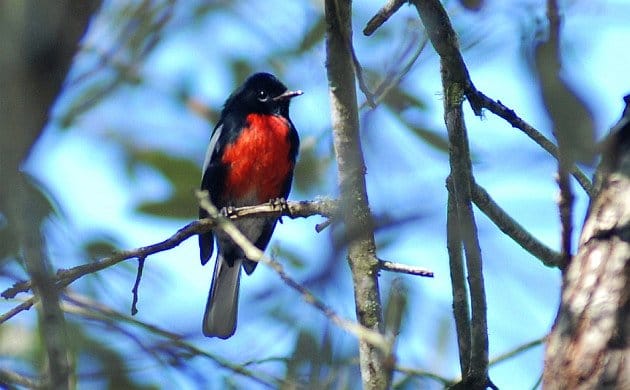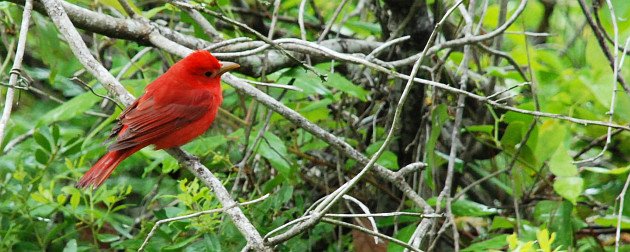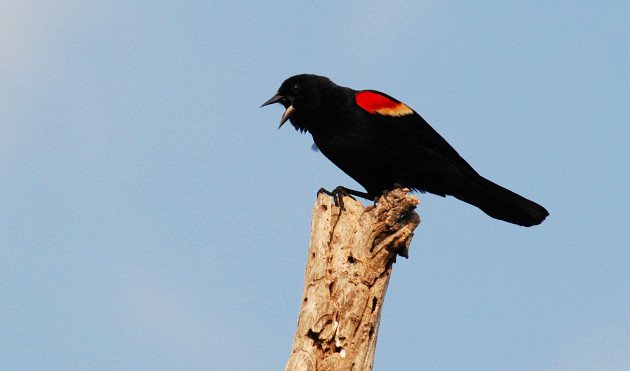
Roughly 10 percent of the world’s birds — about a thousand species — are songbirds belong to a group called “nine-primaried oscines,” so named because the 10th primary feather on their wings is greatly reduced compared with most other birds and for the complex sound-producing structures in their throats (oscine is from a Latin word referring to song). For those of us in the Americas, nine-primaried oscines are among our most familiar and beloved birds: finches; sparrows, juncos, and towhees; warblers; blackbirds, meadowlarks, and orioles; cardinals and grosbeaks; and tanagers. Above is a beautiful member of this group, the Painted Redstart (Myioborus pictus), a warbler.
Because this group is so rich in species, so readily able to exploit a wide range of environments and food sources, debates about how to classify these birds have smouldered for decades. Some scientists have lumped them all into one enormous family (e.g., Sibley and Monroe 1990), but more often, they have been treated as several families. This approach, though, has lead to much confusion over which birds belong in which families (remember when we learned that Piranga tanagers are actually cardinals?), and some of the odder members of the group have never really seemed to belong anywhere in the traditional family structure.

Summer Tanager (Piranga rubra) by David J. Ringer
A new and long-anticipated paper, “Going to Extremes: Contrasting Rates of Diversification in a Recent Radiation of New World Passerine Birds,” by Dr. Keith Barker, et al., provides the most comprehensive look to date at relationships within this group of birds, studying multiple genes in every genus belonging to the group.
The results upheld traditional families within the group but still couldn’t crack some of the interrelationships of those well-recognized groups, nor place several of the oddball taxa, including Yellow-breasted Chat, Wrenthrush, and some of the Caribbean “warblers” and “tanagers.” So, the authors have perhaps “gone to extremes” themselves, by proposing that once the finches are left aside, the remaining several hundred species of predominantly New World birds could be divided into not five or six but 16 different families:
- Calcariidae: longspurs, snow buntings (a family recently recognized by the American Ornithologists’ Union)
- Rhodinocichlidae: the Rosy Thrush-tanager
- Emberizidae: now restricted to Old World buntings
- Passerellidae: the New World sparrows
- Spindalidae: Caribbean spindalises
- Nesospingidae: Puerto Rican Tanager
- Phaenicophilidae: Hispaniolan palm-tanagers and allies
- Zeledoniidae: Wrenthrush
- Teretistridae: Cuban Teretistris warblers
- Parulidae: New World wood-warblers
- Icteriidae: Yellow-breasted Chat
- Icteridae: New World blackbirds, orioles, meadowlarks, etc.
- Calyptophilidae: Hispaniolan chat-tanagers
- Mitrospingidae: three disparate “tanager” genera united by genetic similarities
- Cardinalidae: cardinal-grosbeaks
- Thraupidae: tanagers
Barker et al. argue this approach actually preserves taxonomic stability, by continuing to recognize long-established families, rather than lumping huge numbers of species into very large families and demoting long-recognized groups like blackbirds and warblers (as Sibley and Monroe did in 1990).
But, some are asking, are all these groups really different enough to deserve such an extremely granular family-level approach? (For example, see Birdforum discussions here and here.)
John Boyd adopts what he calls a “compromise phylogeny” of 10 families, noting that uncertainty remains. For example, rather than putting Yellow-breasted Chat in its own family, Boyd puts it within the blackbird family.
So what do you think? Is preserving “traditional” bird families worth doubling or tripling the number of families in this section of the avian tree? (And if we do it here, why not elsewhere in the tree?) Or does it make more sense to have fewer families, even if it means groups like blackbirds and wood-warblers become subfamilies within a larger family?
I think 16 families is too much for me — after all, we’re not talking about groups of birds that have wildly different morphologies or life strategies, here. Could we live with a family that combines tanagers and cardinals? Or blackbirds and warblers? I think so. How about you?

Red-winged Blackbird (Agelaius phoeniceus) by David J. Ringer













I don’t particularly care whether it’s 10 or 16 families, but using Icteridae and Icteriidae for two different families is just asking for trouble.
Terrific analysis as always, David. What really strikes me when considering the questions you raise is how little most of us really understand the concept of families in taxonomy. Most birders have a much more sophisticated insight into the concept of species than the average bear, but when do we ever talk about families?
I guess my question to you is why 16 families would be too much. What practical impact does organization above species level have on anyone?
From an organizational sense I would prefer more, not less nine-primaried oscine songbirds. Having families with 1000 members is unwieldy and usually leads to just an overly heterogenous mix of birds. Not to mention we would just have to refer to all the present families as subfamilies, all the subfamilies as tribes, all the tribes as ?
Recognizing multiple families seem to better preserve our description of taxonomic diversity
As David Truman alluded to above, the decision of how many families to designate is arbitrary until we start using a taxonomic classification standard for all organisms that relies on phylogentic differentiation instead of historical convention. When that day comes the current debating will be moot. I, for one, am not chained by history. If it is arbitrary or wrong, then throw it out. That is the way of true science.
I think I could live with either of those groupings, or with the one we have now. Even with the best genetic and other information, family boundaries are going to be somewhat imprecise and subject to re-evaluation. If 16 families is what makes the most sense now, then so be it. I do wonder whether it makes sense to have four single-species families, but I understand that they might not fit otherwise.
From a birding standpoint, I don’t think it matters much whether there are 16 families or 1 family with 16 subfamilies or some other arrangement in between. We mentally group birds by appearance or behavior in ways that don’t necessarily align exactly with taxonomic divisions. I don’t really see a conflict between thinking about birds that way and recognizing whatever the latest science is.
Given the upheavals in the Old World it is hardly surprising that like the babblers and old world warblers there are major surprises and a number of monotypic families. Also hardly surprising that some of the new families are insular endemics.
While I agree with, and appreciate the taxonomic efforts to better determine relationships between the different bird species, I am mostly unhappy with the constant shifting of orders, families, species etc. It is bad enough that, say, North American compilers cannot get their lists to jive, but when you add the other world ornithological bodies it is a real nightmare. I understand that the current efforts are all in part to come up with some better, universal agreement, but as it stands now, I am finding all the changes to be a real pain.
For instance, eBird / Clements just made major rearrangements to the family Furnariidae based on the genetic analysis of Derryberry et al. (2011) as did John Boyd… yet those two lists for that one family (of around 300 species) differ.
Don’t get me wrong, any list of the worlds birds is a monumental task. However, from a practical standpoint, particularly when it comes to birding field guides, it is insane to keep changing the order of the orders, families, names of families etc. Okay, maybe not “insane,” but I am not sure of the cost vs benefit at the moment.
Regarding the question, and in light of the above, personally I’d be happier with subfamilies. No matter what the consensus is today, the probability of it being changed or overruled tomorrow is high so the fewer major overhauls to how species are grouped, lumped, or split the better.
Good comments by the way – I have to say I agree whole or in part with all of them.
Mike, I think one of the issues is that people tend to want the family-level rank to “mean” something, but it’s arbitrary and so gets applied differently across different parts of the avian tree, not to mention other classes.
Take parrots for example — the divisions within that group are far more ancient than the ones under discussion here, but many authorities seem loath to create even two or three families for this diverse range of species. Is it because their bills are all roughly the same shape (if differently sized)? Or because there are fewer species? Or because they are largely absent from Northern Europe and North America, so western culture and the scientists it produces are less attuned to their differences?
I think a lot of North American birders want families to represent both a “manageable” (Dunbar’s number?) number of species and to align with groups we traditionally regard as different — and that is a matter of culture and familiarity.
So maybe that means the parrots and pheasants get an “unfair” shake, and as you point out, that probably means little in the grand scheme of things. On the other hand, if a highly granular approach highlights the significance of island diversity, as this does for Caribbean species, that’s not a bad thing at all.
Great post, but why is there no link to the actual paper, to Barker’s “new and long-anticipated” study itself?
Here you go:
http://sysbio.oxfordjournals.org/content/early/2012/12/08/sysbio.sys094
or here:
http://sysbio.oxfordjournals.org/content/early/2012/12/29/sysbio.sys094.full.pdf?keytype=ref&%2520ijkey=ftDXOyiWFNCyeyh